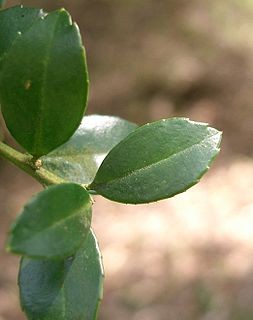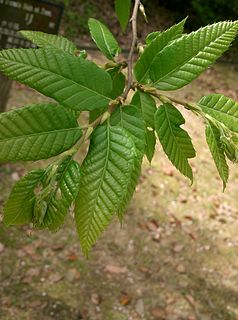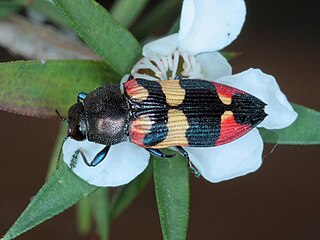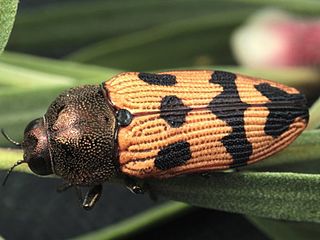
Ilex crenata, the Japanese holly or box-leaved holly is a species of flowering plant in the family Aquifoliaceae, native to eastern China, Japan, Korea, Taiwan, and Sakhalin.

Amphibola crenata is a species of air breathing snail with an operculum, a pulmonate gastropod mollusc which lives in a habitat that is intermediate between the land and the sea, not entirely terrestrial and not entirely marine. This is not a true land snail, but it is also not a true sea snail. Unlike almost all other snails that have opercula, this species breathes air. It is common in New Zealand.

Castanea crenata, known as Korean chestnut, Korean castanea, and Japanese chestnut, is a species of chestnut native to Japan and Korea. Castanea crenata exhibits resistance to Phytophthora cinnamomi, the fungal pathogen that causes ink disease in several Castanea species. The mechanism of resistance of Castanea crenata to Phytophthora cinnamomi may derive from its expression of the Cast_Gnk2-like gene.

Miconia crenata,, commonly called soapbush, clidemia or Koster's curse, is a perennial shrub. It is an invasive plant species in many tropical regions of the world, creating serious damage.

Amphibola is a genus of small, air-breathing terrestrial or semi-marine snails with an operculum, pulmonate gastropod molluscs in the family Amphibolidae.

Fagus crenata, known as the Siebold's beech, Japanese beech, or buna, is a deciduous tree of the beech genus, Fagus, of the family Fagaceae.

The long-footed shrew is a species of mammal in the family Soricidae. It is found in Cameroon, Central African Republic, Republic of the Congo, Democratic Republic of the Congo, Equatorial Guinea, and Gabon. Its natural habitat is subtropical or tropical moist lowland forests.

Gluphisia crenata, the dusky marbled brown, is a moth of the family Notodontidae. The species was first described by Eugenius Johann Christoph Esper in 1785. It is found in Europe, east over parts of Russia and China up to Japan. It is also found in North America, where it was traditionally treated as a separate species, Gluphisia septentrionis.

Harpa crenata, common name the Panama harp, is a species of sea snail, a marine gastropod mollusk in the family Harpidae, the harp snails.
Conturbatia crenata is a species of air-breathing land snail, a terrestrial pulmonate gastropod mollusk in the family Streptaxidae. It is the only species in the genus Conturbatia.

Castiarina is a genus of beetles in the family Buprestidae, tribe Stigmoderini. This is one of the largest genera of beetles in Australia and emerge in the summertime to coordinate with flowering of native plants including Eucalyptus and tea trees (Leptospermum).

Castiarina allensundholmi is a species of beetle in the family Buprestidae, otherwise known as jewel beetles. The species was discovered in October 2003 and was described by Dr Shelley Barker, OAM, in 2005. The three specimens in the type series measure from 7 mm to 8.2 mm. The species belongs in the Castiarina balteata species group which currently comprises three similarly-sized described species: Castiarina balteata, Castiarina williamsi, and Castiarina allensundholmi Barker, 2005.

Castiarina turneri Barker 1983 is a beetle in the Family Buprestidae, otherwise known as jewel beetles. The species was described by Dr Shelley Barker, OAM, in 1983.

Castiarina bella is a species of beetle in the Buprestidae family, which is endemic to Australia and found along the east coast of Australia between Melbourne and Brisbane. It is a fairly common species in this area. As with other Castiarina species it is typically found on flowering shrubs and trees.
Castiarina insculpta, the Miena jewel beetle, is a species of beetle in the jewel beetle family, Buprestidae. It is endemic to Tasmania, where it feeds on the asteraceous shrub Ozothamnus hookeri.
Castiarina purcellae is a species of Australian beetle in the jewel beetle family, Buprestidae, described in 2005.
Castiarina michaelpowelli is a species of Australian beetle in the jewel beetle family, Buprestidae, described in 2005.
Castiarina keyzeri is a species of Australian beetle in the jewel beetle family, Buprestidae, described in 2005.
Castiarina macarthuri is a species of Australian beetle in the jewel beetle family, Buprestidae, described in 2005.

Castiarina nasuta is a species of beetle in the Buprestidae family, which is endemic to Australia and found along the east coast of Australia between Melbourne and Brisbane. It is one of several Jewel Beetles that exhibits Batesian mimicry of Lycid Beetles in the genus Porrostoma as the Lycid Beetles taste vile to predators. C. nasuta can be distinguished from similar species such as C. erythroptera, C. rufipennis and C. subpura by having a crinkly looking pronotum. It is typically found in flowering shrubs such as Leptospermum and Bursaria.













